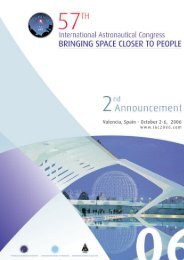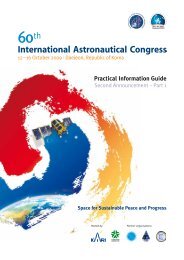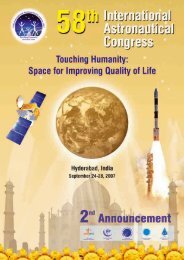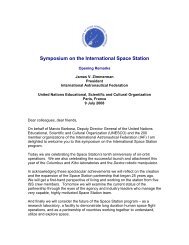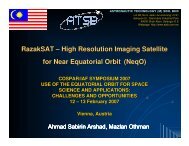Developing an Equatorial Earth Observation Satellite System
Developing an Equatorial Earth Observation Satellite System
Developing an Equatorial Earth Observation Satellite System
You also want an ePaper? Increase the reach of your titles
YUMPU automatically turns print PDFs into web optimized ePapers that Google loves.
National Institute of Aeronautics <strong>an</strong>d Space – LAPAN<br />
Indonesia<br />
<strong>Developing</strong> <strong>an</strong> <strong>Equatorial</strong> <strong>Earth</strong> <strong>Observation</strong> <strong>Satellite</strong> <strong>System</strong><br />
Opportunities for equatorial <strong>an</strong>d near-equatorial EO satellites:<br />
<strong>Equatorial</strong> <strong>an</strong>d near-equatorial EO satellite using selective off-nadir optical viewing<br />
assisted with cloud sensor provide opportunity as following:<br />
• High temporal resolution data acquisition of equatorial EO satellite (e.g. possible of up<br />
to 4 daylight passes for one TERS at 1,680 km MEO to cover 10 0 N <strong>an</strong>d 10 0 S latitude);<br />
• Optimized data acquisition of satellite passes to better serve user requirement;<br />
• Possible access of high spatial resolution data acquisition immediately required the<br />
same day <strong>an</strong>d successive observation for disaster monitoring, as well as other urgent<br />
special detection <strong>an</strong>d dynamic temporal monitoring purpose;<br />
• Possible programming <strong>an</strong>d selection of areas to be observed with acceptable cloud<br />
cover before <strong>an</strong>d during satellite data acquisition;<br />
• Better access of data acquisition for precise timely programmed monitoring of earth<br />
resource process <strong>an</strong>d environment process, e.g. crop yield estimation;<br />
• Multi-instrument payload increase the usefulness of equatorial <strong>an</strong>d near-equatorial EO<br />
satellite, e.g. data relay, space science <strong>an</strong>d others, e.g. multi-mission satellite;<br />
• Extended <strong>an</strong>d systematic high resolution EO data archiving of the equator region;<br />
• Interpretation of equatorial <strong>an</strong>d near-equatorial EO satellite data with variable<br />
illumination <strong>an</strong>d sun <strong>an</strong>gle could provide new detection <strong>an</strong>d application methods;<br />
• More benefit of near-equatorial orbit satellites for EO using imaging radar (SAR);<br />
• Data utilization <strong>an</strong>d benefit by countries located in the equator region.



